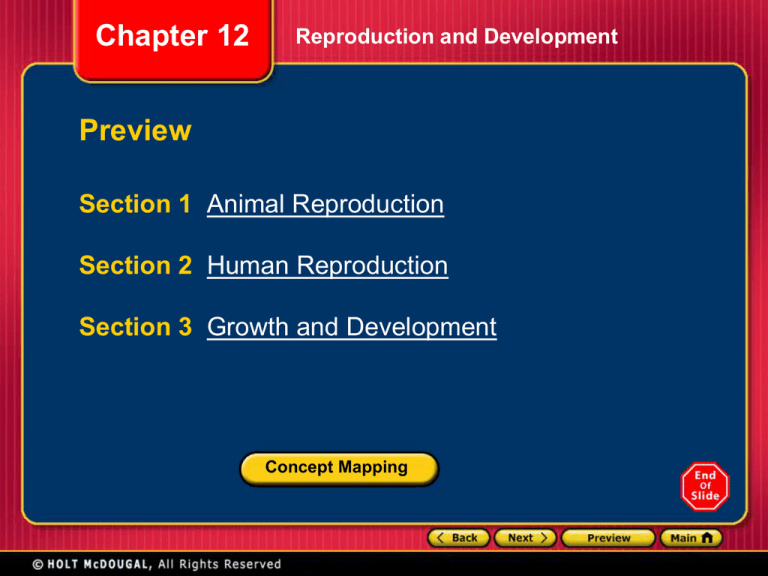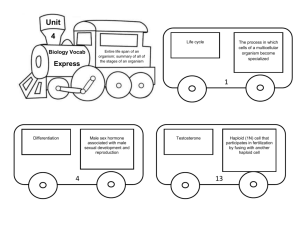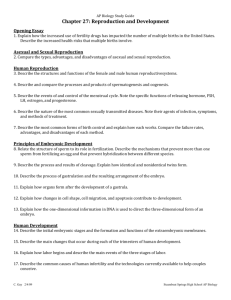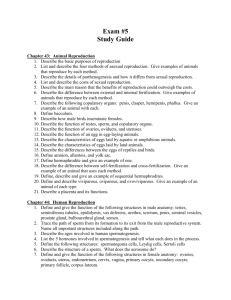sexual reproduction
advertisement

Chapter 12 Reproduction and Development Preview Section 1 Animal Reproduction Section 2 Human Reproduction Section 3 Growth and Development Concept Mapping Chapter 12 Section 1 Animal Reproduction Bellringer Do you know how birds, ants, humans, and sea stars reproduce? Write down any differences that you are aware of in how these animals reproduce. Also write down any differences that you know of in how these animals raise their young. Write your answers in your science journal. Chapter 12 Section 1 Animal Reproduction Objectives • Distinguish between asexual and sexual reproduction. • Explain the difference between external and internal fertilization. • Identify the three different types of mammalian reproduction. Chapter 12 Section 1 Animal Reproduction Asexual Reproduction • In asexual reproduction, a single parent has offspring that are genetically identical to the parent. • Budding, fragmentation, and regeneration are all ways in which a parent organism can produce genetically identical offspring. Chapter 12 Section 1 Animal Reproduction Sexual Reproduction • In sexual reproduction, offspring are formed when genetic information from more than one parent combines. • Sexual reproduction in animals usually requires two parents—a male and a female. • The female parent produces sex cells called eggs. The male parent produces sex cells called sperm. Chapter 12 Section 1 Animal Reproduction Sexual Reproduction, continued Chapter 12 Section 1 Animal Reproduction Internal and External Fertilization • External Fertilization is the process when the sperm fertilizes the eggs outside the female’s body. • Internal Fertilization is the process when the egg and sperm join inside the female’s body. Chapter 12 Section 1 Animal Reproduction Mammals • Monotremes are mammals that lay eggs. • Marsupials are mammals that give birth to partially developed live young. Most marsupials have pouches where their young continue to develop after birth. • Placental Mammals are nourished inside their mother’s body before birth. Chapter 12 Section 2 Human Reproduction Bellringer Do you think that cloning human beings could be considered reproduction? Why or why not? What kind of reproduction is it? Record your answers in your science journal. Chapter 12 Section 2 Human Reproduction Objectives • Identify the structures and functions of the male and female reproductive systems. • Describe two reproductive system problems. Chapter 12 Section 2 Human Reproduction The Male Reproductive System • The male reproductive system produces sperm and delivers it to the female reproductive system. • The testes are a pair of organs that make sperm and testosterone. • Testosterone is the main male sex hormone. It helps regulate the production of sperm and the development of male characteristics. Chapter 12 Section 2 Human Reproduction Chapter 12 Section 2 Human Reproduction The Female Reproductive System • The female reproductive system produces eggs, nurtures fertilized eggs (zygotes), and gives birth. • The two ovaries are the organs that make eggs. • Ovaries also release estrogen and progesterone, the main female sex hormones. These hormones regulate the release of eggs and development of female characteristics. Chapter 12 Section 2 Human Reproduction Chapter 12 Section 2 Human Reproduction The Female Reproductive System, continued • The Egg’s Journey During ovulation, an egg is released from an ovary and passes into a fallopian tube. If the egg is fertilized, the resulting zygote enters the uterus. • When a baby is born, he or she passes through the vagina and emerges outside the body. • The menstrual cycle is a series of monthly changes that prepares the body for pregnancy. Chapter 12 Section 2 Human Reproduction Menstrual Cycle and Uterine Lining Click below to watch the Visual Concept. Visual Concept Chapter 12 Section 2 Human Reproduction Multiple Births • Twins, Triplets, Quadruplets, and More In every 1,000 births, there are about 30 sets of twins. In the United States, there are about two sets of triplets in every 1,000 births. Births of quintuplets or more happen only once in about 53,000 births. Chapter 12 Section 2 Human Reproduction Reproductive System Problems • STDs A sexually transmitted disease (STD) is a disease that can pass from one person to another during sexual contact. STD Approx. # of new cases each year Chlamydia 3 to 10 million Genital HPV 5.5 million Genital herpes 1 million Gonorrhea 650,000 Syphilis 70,000 HIV/AIDS 40,000 to 50,000 Chapter 12 Section 2 Human Reproduction Reproductive System Problems, continued • Cancer Sometimes, cancer happens in reproductive organs. Cancer is a disease in which cells grow at an uncontrolled rate. • Infertility In the United States, about 15% of married couples have difficulty producing offspring. Many of these couples are infertile, or unable to have children. Chapter 12 Section 3 Growth and Development Bellringer Name the stages of physical development that you have gone through in your life so far. What is the next stage of development that you will go through? List some physical and social changes that will happen during this next stage. Are you looking forward to this future stage of life? Record your thoughts in your science journal. Chapter 12 Section 3 Growth and Development Objectives • Summarize the processes of fertilization and implantation. • Describe the development of the embryo and the fetus. • Identify the stages of human development from birth to death. Chapter 12 Section 3 Growth and Development From Fertilization to Embryo • A fertilized egg (zygote) travels down the fallopian tube toward the uterus. Eleven to 12 days after fertilization, the zygote has become a tiny ball of cells called an embryo. Then implantation occurs. Implantation is the embedding of the embryo in the thick, nutrient-rich lining of the uterus. Chapter 12 Section 3 Growth and Development From Embryo to Fetus • The placenta is a special two-way exchange organ. It has a network of blood vessels that provides the embryo with oxygen and nutrients from the mother’s blood. Wastes produced by the embryo are removed in the placenta. Chapter 12 Section 3 Growth and Development From Embryo to Fetus, continued • Weeks 1 and 2 Doctors commonly count the time of a woman’s pregnancy as starting from the first day of her last menstrual period. • Weeks 3 and 4 In week 3, after fertilization, the zygote moves to the uterus. As the zygote travels, it divides many times. At the end of week 4, implantation is complete and the woman is pregnant. Chapter 12 Section 3 Growth and Development From Embryo to Fetus, continued • Weeks 5 to 8 In this stage, the embryo becomes surrounded by a thin membrane called the amnion. The umbilical cord forms. The heart, brain, other organs, and blood vessels start to form. • Weeks 9 to 16 At week 9, the embryo may begin to make tiny movements. After week 10, the embryo is called a fetus. The embryo grows rapidly during this stage. Chapter 12 Section 3 Growth and Development From Embryo to Fetus, continued • Weeks 17 to 24 By week 17, the fetus can make faces. By week 23, the fetus’s movements may be quite vigorous! • Weeks 25 to 36 At about 25 or 26 weeks, the fetus’s lungs are well developed. By the 32nd week, the fetus’s eyes are open and perceive light through the mother’s abdominal wall. Chapter 12 Section 3 Growth and Development Pregnancy Overview Click below to watch the Visual Concept. Visual Concept Chapter 12 Section 3 Growth and Development Birth • A full-term pregnancy usually lasts about 40 weeks. Typically, as birth begins, the mother’s uterus begins a series of muscular contractions called labor. Usually, these contractions push the fetus through the mother’s vagina, and the baby is born. Chapter 12 Section 3 Growth and Development From Birth to Death • Infancy to Childhood Generally, infancy is the stage from birth to age 2. Childhood—another period of fast growth—lasts from age 2 to puberty. • Adolescence The stage from puberty to adulthood is adolescence. During puberty, a person’s reproductive system becomes mature. Chapter 12 Section 3 Growth and Development From Birth to Death, continued • Adulthood From about age 20 to age 40, you will be a young adult. Beginning around age 30, changes associated with aging begin. • The aging process continues in middle age (between 40 and 65 years old). A person who is more than 65 years old is considered an older adult. Chapter 12 Section 3 Growth and Development Chapter 12 Reproduction and Development Concept Mapping Use the terms below to complete the concept map on the next slide. fragmentation Reproduction sexual reproduction internal fertilization an embryo zygote egg budding asexual reproduction Chapter 12 Reproduction and Development Chapter 12 Reproduction and Development








